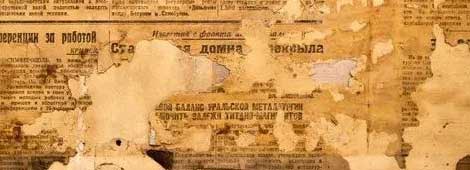


Many people are unsure about how to store the documents they have collected in the course of their genealogical quest. There are a number of considerations in selecting the right storage containers, binders, file folders, and the like. You also have to be aware that anything published on newsprint can spell disaster to documents stored in close proximity to it.
Most of the genealogical items you compile are paper-based materials. These include originals of letters, vital records, land and property records, books, diaries, journals, forms, and other documents. They also include photocopies you make when you visit libraries, archives, and courthouses. In order to ensure the longevity of these papers, you need to know about and recognize their natural enemies.
Original documents may or may not have been produced using archival-safe paper. Some paper products are manufactured using acids or chemicals which degrade or destroy the paper over time. Newsprint is a prime example of high-acid paper. It has been used in newspapers, telephone directories, and other short-term publications. Other materials it comes in contact with can discolor and/or decompose over time. If this paper comes in contact with other paper documents–even through the air–the other documents become “infected” and begin to discolor. Newsprint should be stored separately from other documents. An excellent solution is to make a photocopy of newsprint items and store the copy instead of the original. However, even photocopies may be a problem because not every photocopy paper is acid-free and archival-safe. Check the box or wrapper that the paper comes in; for these purposes, recycled paper is not a good choice.
Storage in cardboard is a definite no-no too. I learned this the hard way. I once purchased a beautiful signed and numbered print, “African Elephants,” by artist John Ruthven. It arrived in a stiff cardboard package. I set the print aside for a year or so before I decided to have it framed and matted. Imagine my horror when the framing gallery owner informed me that the print had been damaged and discolored by the cardboard in which the print had been shipped and stored. The print’s paper had already begun yellowing. Only through the application of a spray-on acid neutralizer and fixative was the damage halted. However, in the meantime, my expensive print had been so damaged that no other collector would ever want it.
Direct sunlight is a deadly enemy to paper products. Light and heat can cause photographic papers to age, fade, discolor, and deteriorate over time. Sunlight and bright light also interact with photographs of all types causing them to fade and disintegrate. (Keep in mind that photographs are created using controlled light exposure and even though the chemicals used and stop bath may halt the chemical developing process, prolonged exposure to bright light will fade some photographs and cause others to darken.)
Moisture and humidity can do more damage than you might think. They certainly can damage paper, causing it to warp, weaken, and deteriorate. They also provide an ideal environment for the formation of mold and mildew and a breeding ground for a variety of insects and parasites.
If you combine direct sunlight, moisture and humidity, acidic paper products, and general neglect, you have a perfect recipe for disaster. Proper storage is not as complicated as you might think, and with a little foresight and planning, you can develop your own archival preservation and storage environment.